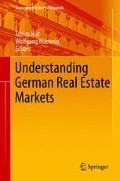Abstract
The German residential market has been in the focus of numerous (opportunistic) international investors in the last decade. In their view the market was undervalued offering significant potential to benefit from rising prices and a rising home-ownership rate, as Germanys was amongst the lowest in Europe. The actual development proved the business plans, based on these assumptions, wrong, as they missed out, that more or less stagnation prices and the low home-ownership rate are the result of the structural framework and the changes during the reunification process that is still not completed yet. A detailed analysis of the development of the demand and supply side reveals this, but also shows that institutional investors are only playing a subordinate role in the German housing market as private owners and investors dominate the market. As construction activity in the multi-family sector is only slowly recovering from its low, this will change slow, supporting the stable performance of the German residential sector already seen in the past.
Notes
- 1.
- 2.
- 3.
- 4.
From 2011 onwards vdpResearch will also provide an index for multi-family housing, calculated in the same way.
References
Deutsche Bundesbank (2002)P. The housing market during the nineties. Deutsche Bundesbank Monthly Report, 54, 27–37.
Federal Statistical Office (2009). Germany’s population by 2060, Results of the 12th coordinated population projection, Wiesbaden: Statistisches Bundesamt.
Federal Statistical Office. (2010). Bauen und Wohnen, Bestand an Wohnungen, Fachserie 5 Reihe 3. Wiesbaden: Statistisches Bundesamt.
Haffner, M., Elsinga, M., & Hoeckstra, J. (2007). Balance between landlord and tenant? A comparison of rent regulation in the private rental sector in five countries. In Paper presented at the ENHR 2007 conference: Rotterdam.
Just, T. (2011). Demographics and German real estate. In T. Just & W. Maening (Eds.), Understanding German real estate. Germany: Springer Verlag.
Knetsch, T.A. (2010). Trend and cycle features in German residential investment before and after reunification. Deutsche Bundesbank Discussion Paper, Series 1: Economic Studies, No 10/2010. Frankfurt am Main: Dt. Bundesbank, Press and Public Relations Div.
Michelsen, C., Weiß, D. (2009). What happened to the East German Housing Market? – A Historical Perspective on the Role of Public Funding. IWH-Diskussionspapiere No. 20. Halle: Institut für Wirtschaftsforschung Halle.
O’Sullivan, E., & De Decker, P. (2007). Regulating the private rental housing market in Europe. European Journal of Homelessness, 1, 95–117.
Voigtländer, M. (2009). Why is the German homeownership rate so low? Housing Studies, 24, 355–372.
Voigtländer, M. (2011). Real estate data sources in Germany. In T. Just & W. Maening (Eds.), Understanding German real estate. Germany: Springer Verlag.
ZIA. (2010). Wohnimmobilien-Indizes Vergleich Deutschland – Großbritannien. Berlin: ZIA Düsseldorf Barkow Consulting.
Author information
Authors and Affiliations
Editor information
Editors and Affiliations
Rights and permissions
Copyright information
© 2012 Springer-Verlag Berlin Heidelberg
About this chapter
Cite this chapter
Cieleback, M. (2012). Development of Residential Property. In: Just, T., Maennig, W. (eds) Understanding German Real Estate Markets. Management for Professionals. Springer, Berlin, Heidelberg. https://doi.org/10.1007/978-3-642-23611-2_16
Download citation
DOI: https://doi.org/10.1007/978-3-642-23611-2_16
Published:
Publisher Name: Springer, Berlin, Heidelberg
Print ISBN: 978-3-642-23610-5
Online ISBN: 978-3-642-23611-2
eBook Packages: Business and EconomicsBusiness and Management (R0)

